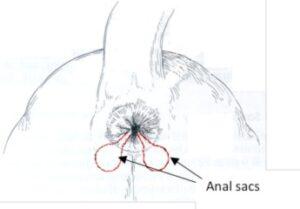 Cats and dogs have two anal sacs: one being located on either side of the anus. These glands are connected to the anus by a small duct each. The anal sacs have a lining which produces a dark, foul-smelling fluid which is stored by the sacs. The function of this fluid is as a scent marker. The anal sacs are normally emptied during a bowel movement and or else during extreme excitement or distress. Sometimes the sacs are not emptied properly which can cause problems for your cat or dog.
Cats and dogs have two anal sacs: one being located on either side of the anus. These glands are connected to the anus by a small duct each. The anal sacs have a lining which produces a dark, foul-smelling fluid which is stored by the sacs. The function of this fluid is as a scent marker. The anal sacs are normally emptied during a bowel movement and or else during extreme excitement or distress. Sometimes the sacs are not emptied properly which can cause problems for your cat or dog.
Diseases of the Anal Sacs
1: Anal Sac Impaction: this occurs when there is an abnormal accumulation of anal sac secretion as a result of infection, inflammation or blockage of the ducts.
2: Infection: this occurs when bacteria grow in the fluid and produce yellow or bloody pus.
3: Abscessation: this occurs when infected material builds up within an impacted sac and this leads to the sac rupturing. When the sac ruptures, a hot, tender abscess forms under the skin around the sac and anus. The abscess may rupture and discharge blood and pus onto the skin. This is very painful and may cause some patients to be fevered and very ill.
Signs of Anal Sac Disease
Anal sac disease may occur in any age, breed or sex but is most common in small and toy breed dogs and is rare on cats. In some animals, the disease may be associated with dermatitis. Many patients may have had diarrhoea or soft stool recently.
There are usually signs of anal irritation such as scooting or dragging itself along the ground, excessive licking under or around the tail, or a bloody or sticky discharge on either side of the anus. Rarely, a patient may be reluctant to pass stool, become constipated, have a reduced appetite or stop eating.

Cat licking at it’s belly can be a sign of anal sac disease
Some dogs are born with anal duct canals that do not close well and constantly drain anal sac fluid, leaving foul-smelling drops behind them. These dogs do not outgrow this problem and anal sac removal is the treatment.
Treatment
1: Anal Sac Impaction: The treatment for impaction is to express or empty the material from the sacs. It may also be necessary to flush the sacs and fill them with anti-inflammatory and antibiotic medication.
2: Anal Sac Infection and Abscessation: Antibiotics and pain relief are necessary to treat an anal sac abscess and in some cases surgical drainage under sedation or general anaesthetic is necessary.
3: Surgical Treatment: Despite treatment many patients have recurring or persisting anal sac disease. This can be painful and distressing for the patient. Most of these patients are best managed by surgical removal of the anal sacs. Most patients recover uneventfully from this surgery.
If you are concerned your pet may have anal sac disease, phone City Vet on 061-419760 to arrange an appointment to have them seen.